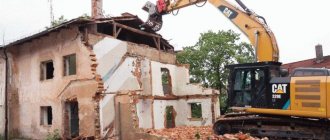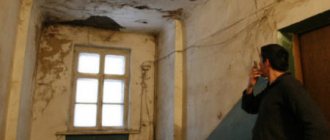In 2021, new rules apply for recognizing an apartment building as unsafe and subject to demolition or reconstruction. The procedure for resettlement from emergency housing has also changed. Legislator:
— formulated the basis on which the apartment building is recognized as unsafe and subject to demolition or reconstruction; — supplemented the rules for working with documents that the local self-government body receives and prepares after assessing and inspecting a house; — provided for new mechanisms for resettlement from emergency housing; — determined for which emergency buildings the decision on demolition or reconstruction is made by the local self-government body; — established a new procedure for calculating the amount of compensation for seized premises.
Document: New rules for recognizing a house as unsafe are in Government Decree No. 1535 dated November 29, 2019. It amended the regulations approved by Government Decree No. 47 dated January 28, 2006 (hereinafter referred to as Regulation No. 47)
It became clear on what basis to recognize apartment buildings as emergency
According to the new rules, an apartment building is recognized as unsafe and subject to demolition or reconstruction if its load-bearing building structures or the entire house as a whole are in emergency technical condition.
There are two signs of emergency technical condition of building structures.
1. Damage and deformation, which indicate the exhaustion of the bearing capacity and the danger of collapse of an apartment building.
2. Rolls, which can cause the house to lose stability.
Both characteristics are indicated in the new version of paragraph 34 of Regulation No. 47.
Standard service life of residential buildings
The main technical indicator that is taken into account during the current maintenance of apartment buildings is the standard service life.
This parameter may vary significantly depending on the following factors:
- from the date of commissioning of a series of houses according to the same type of project;
- on the composition of building materials and structures used in the construction of the building;
- on the environmental conditions in which the residential building is built and operated.
The specified regulatory period is an estimate, since it establishes an approximate period of time during which the safe use of the house for its intended purpose (residence of citizens) is guaranteed.
To calculate standard periods, various methods are used that are associated with determining the normal service life of all main structures and elements of a building - floors, stairs, walls, foundations, etc.
In practice, in most cases, the standard period stated in the project can be significantly exceeded without creating a threat of destruction or damage to the building.
This is directly affected by work to maintain the house in proper condition - current and major repairs.
The frequency of current and major repairs is planned by management companies or housing and communal services enterprises, taking into account both the actual condition of the houses and in accordance with the standard service life.
The commission and the LSG body set deadlines for working with documents
The legislator established more specific rules for the work of the commission for assessing and examining apartment buildings. It is she who decides whether there are grounds to recognize the house as unsafe and subject to demolition or reconstruction. The commission sets out its conclusions in the conclusion. It is drawn up on the form from Appendix No. 1 to Regulation No. 47.
Sample 1—at the end of the article.
The commission sends two copies of the conclusion to the local self-government body. According to the new rules, she must do this within three days after she issued the conclusion. In the old version of Regulation No. 47, the deadline was not specified.
Sample 2 is at the end of the article.
After the LSG body has received the commission’s conclusion, it must make a decision on the house. Reflect it in a municipal act (see sample 2). If you have recognized the apartment building as unsafe and subject to demolition or reconstruction, send the decision, along with the commission’s conclusion, to the applicant and to the municipal housing control body at the location of the house. The deadline is five days from the day you made the decision. It is not necessary to send paper documents. You can send them electronically via the Internet, including through a single or regional portal of state and municipal services.
Responsibilities of the commission
After the appointment of an interdepartmental commission to resolve housing issues, its responsibilities are as follows:
- Determine the suitability of a house, apartment, or other premises for housing, referring to legal requirements and regulations on the assessment of residential real estate;
- Consider complaints received from owners or organizations within the prescribed period;
- Determine the technical capabilities of carrying out major repairs, reconstruction, redevelopment, etc.
The activities of the interdepartmental commission are controlled and directed by its chairman, who in turn is authorized to:
- Involve a variety of housing inspection specialists, other relevant organizations, and management companies in the process;
- Carry out opening of structural elements of the building;
- Involve employees of housing maintenance institutions in the examination;
- Interview property owners and tenants to clarify the nuances and make the final decision of the commission;
- Order the elimination of identified defects and instructions within a specified period;
- Call responsible department officials to a meeting to consider the issue of a specific house.
LSG bodies now make decisions not only on municipal buildings
Local self-government bodies now have the authority to declare residential premises of not only municipal, but also private housing stock unsuitable for habitation. The same rule is established for apartment buildings: recognizing a house as unsafe and subject to demolition or reconstruction is almost always the authority of the local self-government body. An exception is MKD, all residential premises in which are owned by the Russian Federation or the region. Previously, these powers of the local government body extended only to residential premises and apartment buildings that belong to the municipal housing stock.
What is the procedure for recognizing housing as unsafe?
Previously, houses were recognized as unsafe based on a decision of an interdepartmental municipal commission. In accordance with the Decree of the Government of the Russian Federation of November 29, 2021 No. 1535 “On amendments to the Regulations on recognizing premises as residential premises, residential premises unsuitable for habitation...”, an examination is now required for the conclusion. It is carried out by specialized organizations that have the right to carry out work to examine the condition of the soils of the foundations of buildings, structures and their building structures.
Subsequently, the interdepartmental commission, within three days, sends the results of the examination to the relevant federal government body, the executive body of the constituent entity of the Russian Federation, as well as the local government body for decision-making. In addition, the results of the examination are received by the applicant and (or) the state housing supervision body (municipal housing control) at the location of the premises or apartment building.
New mechanisms for resettlement from dilapidated houses have emerged
Document: Federal Law No. 473-FZ dated December 27, 2019 amended the Housing Code and Federal Law No. 185-FZ dated July 21, 2007 “On the Fund for Assistance to the Reform of Housing and Communal Services”
If an apartment building is recognized as unsafe, all residential premises in it become unsuitable for living (clause 4, article 15 of the Housing Code). The residents need to be resettled. Law No. 473-FZ preserved all existing mechanisms for resettlement from emergency housing and introduced new ones.
Regional authorities may introduce additional housing support measures for apartment owners in emergency apartment buildings. For example, the region can provide such citizens with subsidies to offset part of the costs of purchasing new housing. Those who own an apartment in a dilapidated building and decide to buy a new one on credit can count on compensation for mortgage loans. At the same time, it will be possible to use federal budget funds to subsidize preferential mortgages and create flexible housing stock.
New support measures will not be available to all residents of houses recognized as emergency in accordance with the procedure established by law. On the date the apartment building is recognized as unsafe, the owner should not own any other residential premises suitable for permanent residence. The region will not provide support to those who rent another residential premises under a lease agreement or occupy it on a social tenancy basis.
We will have to pay more for residential premises seized for municipal needs
Note: Follow the new rule also in cases where you withdraw housing in connection with the seizure of the land plot on which the house is located
When local authorities resettle a dilapidated building, they seize the housing for municipal needs. In this case, the owners of residential premises must be paid compensation. Include in this amount the market value of not only the premises and common property in the apartment building, but also the land plot on which the house is located. This requirement is specified in the new edition of Part 7 of Article 32 of the Housing Code. An increase in the amount of compensation is an additional measure of support for citizens who are being relocated from emergency housing stock.
Violations of sanitary and hygienic conditions
Homeowners and interested parties can also exercise the right to conduct an examination if sanitary and hygienic conditions are violated. These include the lack of lighting in the room or the absence of rooms, windows opening under hanging arches or covered galleries, regular vibrations, the level of which cannot be reduced. It is impossible to determine their maximum permissible level on your own. This requires special devices. The same applies to increased noise levels, which are strictly regulated by law. Noise is the reason for declaring housing unsuitable for normal and safe living if its original cause cannot be eliminated or reduced with the help of any sound insulation.
Sanitary and hygienic violations include humidity and temperature conditions of the room. You can’t do without specialized equipment here either. Just as in the previous paragraphs, the defect must be eliminated or citizens must be relocated to safe housing. Harmful fumes are also taken into account when a house is located next to an industrial facility.
We secured the right of residents of emergency buildings to temporary housing from the flexible fund
If it is dangerous to stay in a dilapidated building, its residents have the right to receive temporary housing from the flexible fund at the municipal or regional level. This guarantee did not previously apply to residents of houses recognized as unsafe. Now, in such a situation, the local self-government body must allocate temporary housing at the first request of a citizen.
Provide temporary housing from a flexible fund for a period of no more than two years. During this time, you must pay the citizen compensation to purchase a new apartment or provide him with new housing.
Standards depending on construction materials
Depending on the quality and type of materials used in the construction of buildings, their service life is calculated:
- Buildings made using frame technology, as well as those built in bulk, can last about 30 years with proper maintenance.
- Houses in the construction of which such materials as logs and timber were used can be used for about 50 years.
- Buildings, called panel buildings, equipped with reinforced concrete floors, are designed for a service life of about 80 years.
- Buildings made of brick, the so-called light category - 100 years.
- Houses whose walls are 2.5 bricks thick can be used for more than 120 years.
We determined the conditions for financial support for relocation from dilapidated houses
It is now possible to spend subsidies from budgets of all levels to solve the problem of emergency housing. The law allows them to be distinguished:
— residents of dilapidated buildings — for the purchase of new housing; — companies that implement projects for the development of built-up areas or integrated development of territories; - citizens who have the right to receive compensation for seized premises.
First of all, it is envisaged to provide subsidies to developers who have concluded agreements with local self-government bodies on the integrated development of built-up areas. The subsidy compensates for the costs of fulfilling obligations to create and transfer residential premises to municipal ownership for citizens resettled from dilapidated houses. Such a subsidy should not exceed 25 percent of the standard resettlement cost. It is calculated based on the total area of residential premises from which people were relocated and the standard cost per square meter.
The Housing and Communal Services Reform Assistance Fund will also provide funds for resettlement from dilapidated housing. If a region wants to receive financial support from the fund, it should not provide or use land plots on which emergency housing stock apartment buildings were located. An exception is cases when the site is provided for certain objects: for example, public utilities and social services, healthcare, education. Land plots that are cleared from dilapidated buildings at the expense of the federal budget can only be used for the construction of social facilities or for the creation of public spaces.
The region distributes the funds received from the fund among municipalities on whose territory there are unsafe houses. Municipalities, as usual, can learn about the amount of shared funding for relocation from dilapidated housing from local budget funds from the program of their region. But previously this volume was set for the entire period of the program. Now - only for the current and two subsequent years.







